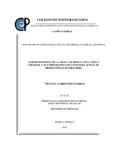| dc.contributor.author | Coronado Flores, Violeta | |
| dc.creator | CORONADO FLORES, VIOLETA; 220174 | |
| dc.date.accessioned | 2020-02-19T17:27:08Z | |
| dc.date.available | 2020-02-19T17:27:08Z | |
| dc.date.issued | 2019-11 | |
| dc.identifier.uri | http://hdl.handle.net/10521/4268 | |
| dc.description | Tesis (Doctorado en Ciencias, especialista en Estrategias para el Desarrollo Agrícola Regional).- Colegio de Postgraduados, 2019. | es_MX |
| dc.description.abstract | El objetivo de este trabajo es realizar un estudio comparativo de los agroecosistemas de producción tradicional y colonial de cochinilla que existieron en el obispado de Tlaxcala en el siglo XVI. Estos agroecosistemas históricos no se han descrito, ni analizado como sistemas distintos. Los agroecosistemas históricos se compararon y contrastaron con el sistema actual de producción del insecto en invernadero, en Tlaxcala, México. La investigación fue cualitativa, comparativa y con una perspectiva histórica. El agroecosistema tradicional de cría de la cochinilla del siglo XVI se llevaba a cabo en huertos y los indígenas aprovechaban los nopales y tunas para la alimentación, así como los nopales para la producción de cochinilla; se basó en el conocimiento tradicional de los campesinos indígenas y se adaptó a diferentes ecosistemas. El agroecosistema colonial es el resultado del sincretismo del conocimiento tradicional indígena y el conocimiento español para la intensificación de la producción, transformándolo en un monocultivo. Este sistema productivo tuvo mucho éxito, pero se basó en la explotación constante de la mano de obra indígena, lo que finalmente llevó a su extinción. El sistema actual es un sistema intensivo, que separa la cría de grana en dos procesos, el cultivo del nopal y la cría del insecto en un ambiente protegido. Los productores de grana son campesinos, que carecían de los conocimientos técnicos agrícolas sobre la cría del insecto, pero mediante la observación, conocimiento del entorno, la movilización de sus conocimientos campesinos, el método de ensayo y error y la alta inversión laboral en la cría de la grana, han logrado obtener grana de primera calidad. _______________ COCHINEAL AGROECOSYSTEMS IN THE COLONIAL PERIOD AND ITS COMPARISON WITH ACTUAL GREENHOUSE PRODUCTION SYSTEMS. ABSTRACT: The objective of this work is to carry out a comparative study of the agroecosystems of traditional and colonial production of cochineal that existed in the bishopric of Tlaxcala in the 16th century. These historical agroecosystems have not been described, nor analyzed as distinct systems. The historical agroecosystems were compared and contrasted with the current system of production of the insect on a greenhouse, in Tlaxcala, Mexico. The research was qualitative, comparative, and with a historical perspective. The traditional cochineal agroecosystem of the 16th century was carried out in orchards, and the natives took advantage of the nopales and prickly pears for food, as well as the nopales for the production of cochineal; it was based on the traditional indigenous peasant knowledge and adapted to different ecosystems. The colonial agroecosystem is the result of the syncretism of indigenous traditional knowledge and Spanish knowledge for the intensification of production, transforming it into a monocropping. This productive system was very successful, but based on the constant exploitation of the indigenous workforce, which finally led to its extinction. The current system is an intensive system, which separates the grana rearing into two processes, the nopal cultivation and the insect rearing in a protected environment. Grana producers are peasants, who lacked the technical agricultural knowledge about the production of cochineal. However, through observation, knowledge of the environment, the mobilization of their peasant knowledge, the trial and error method, and the high labor investment in the breeding of the insect, they have managed to obtain top quality cochineal. | es_MX |
| dc.description.sponsorship | Consejo Nacional de Ciencia y Tecnología (CONACyT). | es_MX |
| dc.format | pdf | es_MX |
| dc.language.iso | spa | es_MX |
| dc.rights.uri | http://creativecommons.org/licenses/by-nc-nd/4.0 | es_MX |
| dc.subject | Dactylopius coccus Costa | es_MX |
| dc.subject | Conocimiento tradicional | es_MX |
| dc.subject | Campesinos | es_MX |
| dc.subject | Traditional Knowledge | es_MX |
| dc.subject | Peasants | es_MX |
| dc.subject | Estrategias para el Desarrollo Agrícola Regional | es_MX |
| dc.subject | EDAR | es_MX |
| dc.subject | Doctorado | es_MX |
| dc.subject.classification | BIOLOGÍA Y QUÍMICA::CIENCIAS DE LA VIDA::BIOLOGÍA DE INSECTOS (ENTOMOLOGÍA)::DESARROLLO DE LOS INSECTOS | es_MX |
| dc.title | Agroecosistemas de la grana cochinilla en la época colonial y su comparación con un sistema actual de producción en invernadero. | es_MX |
| dc.type | Tesis | es_MX |
| Tesis.contributor.advisor | Caso Barrera, Laura | |
| Tesis.contributor.advisor | Aliphat Fernández, Mario Manuel | |
| Tesis.contributor.advisor | Sánchez Hernández, Miguel | |
| Tesis.contributor.advisor | Juárez Sánchez, José Pedro | |
| Tesis.contributor.advisor | Thomé Da Cruz, Fabiana | |
| Tesis.date.submitted | 2019-11 | |
| Tesis.date.accesioned | 2020 | |
| Tesis.date.available | 2020 | |
| Tesis.format.mimetype | pdf | es_MX |
| Tesis.format.extent | 5,522 KB | es_MX |
| Tesis.subject.nal | Grana | es_MX |
| Tesis.subject.nal | Opuntia ficus-indica | es_MX |
| Tesis.subject.nal | Ensayos de variedades | es_MX |
| Tesis.subject.nal | Variety trials | es_MX |
| Tesis.subject.nal | Factores bióticos | es_MX |
| Tesis.subject.nal | Biotic factors | es_MX |
| Tesis.subject.nal | Invernaderos | es_MX |
| Tesis.subject.nal | Greenhouses | es_MX |
| Tesis.subject.nal | Toluca de Guadalupe, Terranate, Tlaxcala, México | es_MX |
| Tesis.rights | Acceso abierto | es_MX |
| Articulos.subject.classification | Cochinilla (tinte) | es_MX |
| dc.type.conacyt | doctoralThesis | es_MX |
| dc.identificator | 2||24||2413||241302 | es_MX |
| dc.contributor.director | CASO BARRERA, LAURA; 15404 | |
| dc.audience | generalPublic | es_MX |


